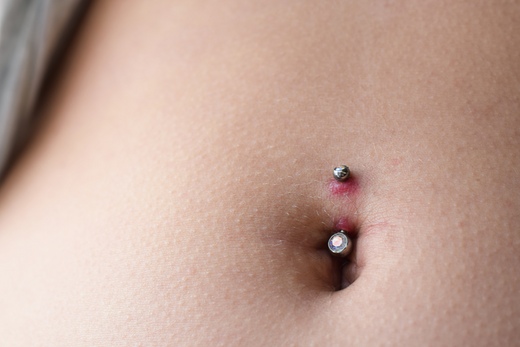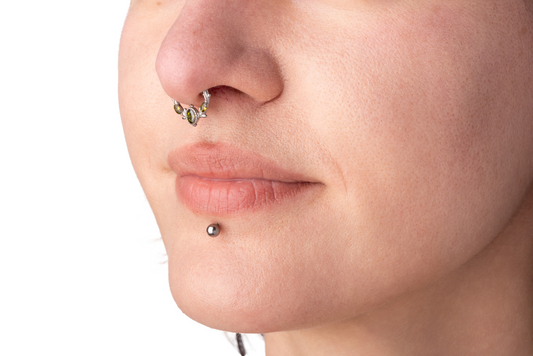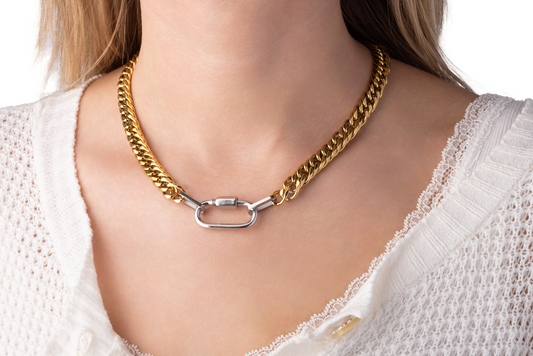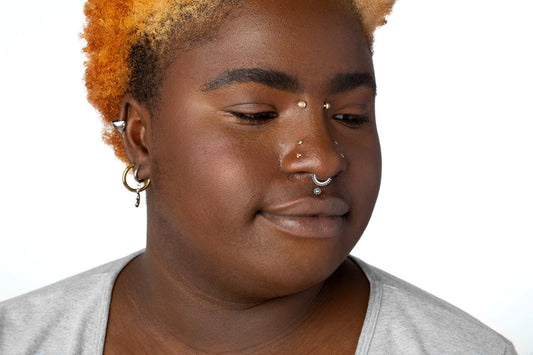Body piercings are a popular form of self expression, but not every piercing journey goes as smoothly as hoped. One potential complication (though infrequent) is rejection -- when the body views the jewelry as a foreign object and attempts to push it out. In this guide, we'll explain what rejection is, how to recognize it, and the steps to take if it happens to you.
What is Piercing Rejection?
Rejection occurs when the body treats the jewelry as a threat and works to expel it, moving the jewelry closer to the surface of the skin over time. While this is possible with any piercing, surface piercings (like eyebrow, navel, or dermals) are more prone to rejection due to shallow tissue of the piercing area.
Factors that can increase risk include:
- Poor quality jewelry or non-biocompatible materials: Low quality pieces (even in healed piercings) can cause the body to expel the jewelry out.
- Excessive movement or trauma to the piercing: Think of a really bad snag or tear that can trigger rejection.
- Improperly fitted jewelry: Jewelry that is too small, tight, or thin can slice it's way to the surface of the skin.
Signs of Piercing Rejection:
Catching the signs of rejection early is key to minimizing damage.
Here's what to look for:
- Jewelry moving closer to the surface: If you notice your jewelry sitting shallower than before, it may be a sign of migration/rejection.
- Thinning skin between the piercing and the surface: The skin holding the jewelry becomes progressively thinner as rejection occurs.
- Redness, peeling, or scar-like tissue forming: A lingering redness or development of irritation bumps or scabs around the piercing.
- An increase in discomfort or irritation: Pain or sensitivity after the initial healing period could indicate a problem.
What to Do if You Suspect Piercing Rejection:
If you notice any of these signs, the first step should be to consult a professional piercer before removing jewelry. A trusted piercer will be able to confirm whether the piercing is rejecting as well as provide assistance in retiring the piercing.
If your piercing is rejecting, it is recommended to take the following steps:
- Remove the jewelry safely: If you are certain your piercing is rejecting, removing the jewelry can help avoid further damage. Consult a professional piercer before removal to confirm the situation and discuss further steps.
- Avoid reinserting jewelry into the same location: Once the piercing is retired, leave it alone! Reinserting the jewelry may cause further rejection or scarring.
- Care for the wound: Treat the site like a fresh wound. Clean gently with saline solution and keep it protected from dirt or irritation.
- Consider alternatives: If you still want a similar look, discuss alternative placements or jewelry types with your piercer. The area will need to be completely healed before a piercer will consider re-piercing the site.
How to Prevent Piercing Rejection:
While rejection is a valid concern, being pierced by a professional and skilled piercer is the best form of prevention.
Here are additional tips to reduce your risk:
- Choose high quality jewelry: Opt for materials like titanium, surgical steel, and gold that are less likely to cause a reaction.
- Choose a skilled piercer: Proper placement can reduce tension on the skin and improve healing outcomes.
- Follow aftercare instructions: Clean your piercing regularly with saline solution and avoid touching unnecessarily.
- Be mindful of pressure and movement: Avoid snagging your jewelry on clothing or exposing it to undue pressure.
Piercing rejection can be disappointing, but with knowledge and early intervention, you can minimize damage and improve your chances of a successful future piercing. Always consult with a trusted professional for advice tailored to your body and piercing needs.
By staying informed, you can enjoy the beauty and self-expression of body piercings with confidence and care.




